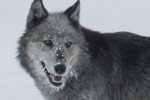Hunters and trappers have killed 2,567 gray wolves in the U.S.’s lower 48 states since 2011, according to recent data. Gray wolves (Canis lupus) were protected by the Endangered Species Act (ESA) for nearly 40 years before being stripped of their protection status by a legislative rider in 2011. Last year total wolf populations were estimated at over 6,000 in the region.
However, wolf advocates say the high numbers of wolves killed means that U.S. states are incapable of adequately protecting the country’s wolves.
“If this senseless slaughter doesn’t convince the Obama administration we need to reverse course on plans to drop wolf protections, the bloodbath will go on,” said Amaroq Weiss with the Center for Biological Diversity. “States are making it very clear that they have no interest in managing wolf populations in a sustainable way.”
Gray wolves were almost entirely exterminated from the lower 48 states during the 19th Century when they were targeted as pests and competitors, but clung on in northern Minnesota. Their comeback began in 1978 when the U.S. Federal Government listed wolves as a protected species under the ESA. Since then Minnesota’s wolf populations have expanded across to nearby Wisconsin and Michigan. Meanwhile, in the late 1990s, wolves returned to the U.S. Rocky Mountains via migrating populations out of Canada and reintroduction efforts in Yellowstone National Park. Since then the wolf has spread to Idaho, Montana, and Wyoming–all of which currently allow hunting. In more recent years, wolves have also expanded into Washington, Oregon, and California, though none of these states currently allow hunting.

Reintroduced wolf in Yellowstone National Park. Photo by: Barry O’Neill/U.S. Park Service.
According to recent data, 912 wolves have been killed over the past two years in Idaho, 566 in Montana, 562 in Minnesota, 374 in Wisconsin, 130 in Wyoming, and 23 in Michigan, which recently closed its first wolf-hunting season. Minnesota has the most wolves of any state in the lower 48, but has seen the population drop dramatically in the past couple years.
Since their rebound, wolves have garnered a lot of political enemies. They have been blamed widely for livestock kills, although many states have reimbursement programs and in some places livestock kills actually decreased due to less coyote presence since they were intimidated by the new kings on the block. The large canids have also been blamed for elk predation, which many hunters see as solely their purview. Views of wolves as savage, ruthless, and even dangerous have also reemerged, despite little evidence that healthy wolves pose much risk to people.
Despite such prejudices, decades of research has shown that wolves, and other apex predators, are actually vital to thriving, biodiverse ecosystems. Wolves exert ecological influence by checking elk and deer populations as well as confining these populations to certain areas. For example, scientists studying the impact of reintroduced wolves in Yellowstone National Park found that new forests began to spring up after elks, which no longer felt free to roam and browse at will, took to more mature forests. The new forests brought greater biodiversity and ecosystem services. For example, new trees meant the return of another ecological standout: the beaver. Wolves also help maintain and control populations of meso-predators, such as coyotes.
Last year, the U.S. Department of Interior proposed delisting wolves entirely from the ESA across the lower 48, except for a small population of Mexican wolves (Canis lupus baileyi), a distinct subspecies. Worldwide, gray wolves are currently listed as Least Concern by the IUCN Red List and their population is considered stable.
Related articles
Over 75 percent of large predators declining

(01/09/2014) The world’s top carnivores are in big trouble: this is the take-away message from a new review paper published today in Science. Looking at 31 large-bodied carnivore species (i.e those over 15 kilograms or 33 pounds), the researchers found that 77 percent are in decline and more than half have seen their historical ranges decline by over 50 percent. In fact, the major study comes just days after new research found that the genetically-unique West African lion is down to just 250 breeding adults.
Lions face extinction in West Africa: less than 250 survive

(01/08/2014) The lions of West Africa, which may represent a distinct subspecies, are on the precipice of extinction. A sober new study in PLOS ONE reports that less than 250 mature lions survive in the region. Scientists have long known that West Africa’s lions were in trouble, but no one expected the situation to be as dire as it was. In fact, in 2012 scientists estimated the population at over 500. But looking at 21 parks, scientists were shocked to find lions persisted in just four with only one population containing more than 50 individuals.
Conserving top predators results in less CO2 in the air

(06/19/2013) What does a wolf in Yellowstone National Park have in common with an ambush spider on a meadow in Connecticut? Both are predators and thus eat herbivores, such as elk (in the case of wolves) and grasshoppers (in the case of spiders). Elk and grasshoppers also have more in common than you probably imagine: they both consume large quantities of plant matter. While scientists have long-known that predators lead to carbon storage by reducing herbivore populations, a new study reveals a novel way in which top predators cause an ecosystem to store more carbon.
Obama Administration to propose stripping protection from all gray wolves
(04/29/2013) The U.S. Fish and Wildlife Service (USFWS) is proposing to end protection for all gray wolves (Canis lupus) in the lower 48 states, save for a small population of Mexican wolves in New Mexico, reports the Los Angeles Times. The proposal comes two years after wolves were removed from the Endangered Species Act (ESA) in western states by a legislative rider on a budget bill, and soon after in the midwest. Since then hunting and trapping has killed over 1,500 wolves in these two regions.
Over 1,500 wolves killed in the contiguous U.S. since hunting legalized

(02/06/2013) Hunters and trappers have killed approximately 1,530 wolves over the last 18 months in the contiguous U.S., which excludes Alaska. After being protected under the Endangered Species Act (ESA) for 38 years, gray wolves (Canis lupus) were stripped of their protected states in 2011 by a legislative rider (the only animal to ever be removed in this way). Hunting and trapping first began in Montana and Idaho and has since opened in Wyoming, Minnesota, and Wisconsin.